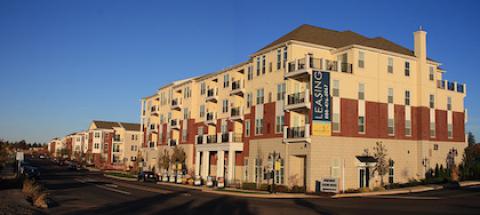Things haven’t been easy for renters over the past few years. Low vacancy rates—as more people move into rentals and fewer people move out—have meant skyrocketing prices. Add in years of stagnant wages, and it’s easy to comprehend why making rent is becoming a more difficult prospect for many families. And according to a new report, things may only get worse in the decade to come.
Recent research from the Harvard Joint Center for Housing Studies and Enterprise Community Partners, a real-estate research and investment organization, suggests that over the next 10 years, the rental population in the U.S. will climb by about 4 million people. (That’s actually a conservative estimate compared to the Urban Institute’s projections.)
The researchers estimate that the current rental crunch—the one where vacancies are around 7 percent, about half of renters spend more than 30 percent of their salaries on housing, and one quarter spend 50 percent or more—is only going to get worse over the next decade. Even if housing prices and income rise as quickly as inflation (about 2 percent annually) the number of severely rent-burdened Americans (those paying 50 percent or more) would increase by 11 percent over the decade, to over 13 million people in 2025.
To get those numbers, Allison Charette, Chris Herbert, Andrew Jakabovics, Ellen Tracy Marya, and Daniel T. McCue, the authors of the paper, took a look at estimated population growth, household formation, and patterns in homeownership in order to figure out how many more households will form over the next decade, and how many of them will rent instead of buying. According to their estimates, the current trend—where fewer Americans opt for homeownership—will continue. And that could be bad news for household finances, since a greater number of Americans will wind up using a major chunk of their income just to pay for housing.
The authors ran several scenarios and only in the most optimistic one, when they estimated that household incomes outpaced inflation by 1 percentage point every year, does the number of burdened renters decrease at all. And even then, the decline was only 1.4 percent.
And an affordable housing shortage persists—both in existing structures and when it comes to the building pipeline, which means that even though construction seems to be happening everywhere in most major cities, much of that won’t help those struggling to make monthly payments.
Also of concern is how this renting crisis will coincide with the shifting demographics of the country. During the next decade, the minority population in the U.S. will continue to grow, but minorities are also much more likely to have difficulty making their paychecks stretch to accommodate growing rental prices—about one-quarter of minority renters have financial burdens compared to less than 20 percent for white households, according to the paper from Harvard.
And there’s bad news for the two largest generation populations, too. Stagnant wages, high rental prices, and decreased employment opportunities during (and following) the recession may continue to play out over the next decade for Millennials. Since the generation hasn’t been able to accumulate much wealth, they’re less likely to be prepared to buy homes or to have savings or other investments that can defray some of the burden of rental costs.
The outlook is especially troubling for the elderly. As the massive Boomer population ages, their financial limitations will likely mean more rent-burdened older Americans. Already, the report notes, 30 percent of elderly renters use more than half of their income on housing, that’s more than the national average. When it comes to aging, renters are often in a much worse financial position than their peers who were able to purchase homes. According to the study, the median American over the age of 65 who owns their own home, has enough wealth to afford 42 months of care in a nursing home. But the median renter over the age of 65 wouldn’t have enough wealth on hand to cover even one.
These findings are especially distressing given the fact that substantial economic gains feel like wishful thinking after years of mostly stagnant incomes. And if current patterns persist, with rent prices increasing more quickly than incomes, each 0.25 percentage point increase in rent will mean an additional 400,000 Americans who are spending half of their pay on housing, leaving them little money to spend on their other basic needs.
[Gillian B. White is a senior associate editor at The Atlantic.]


Spread the word